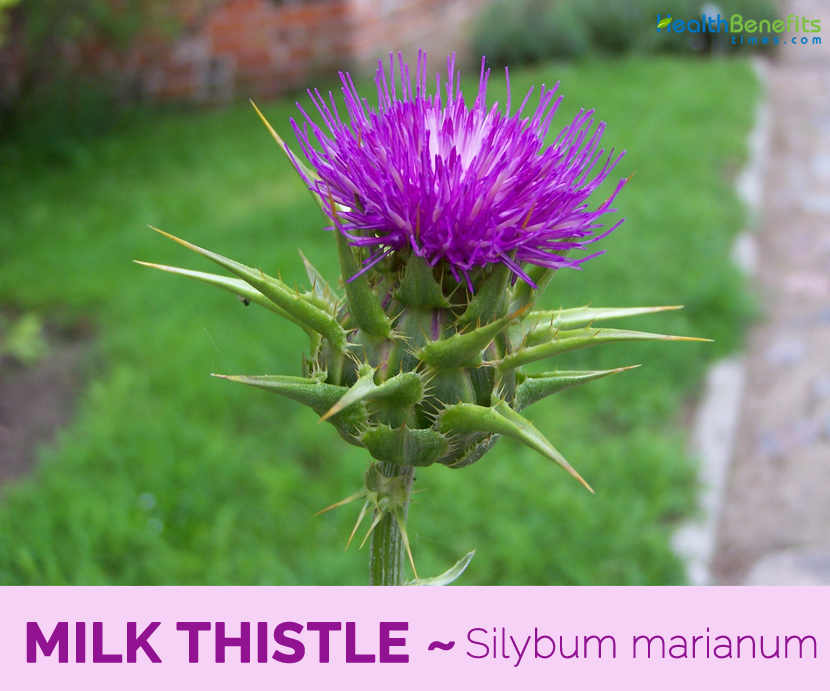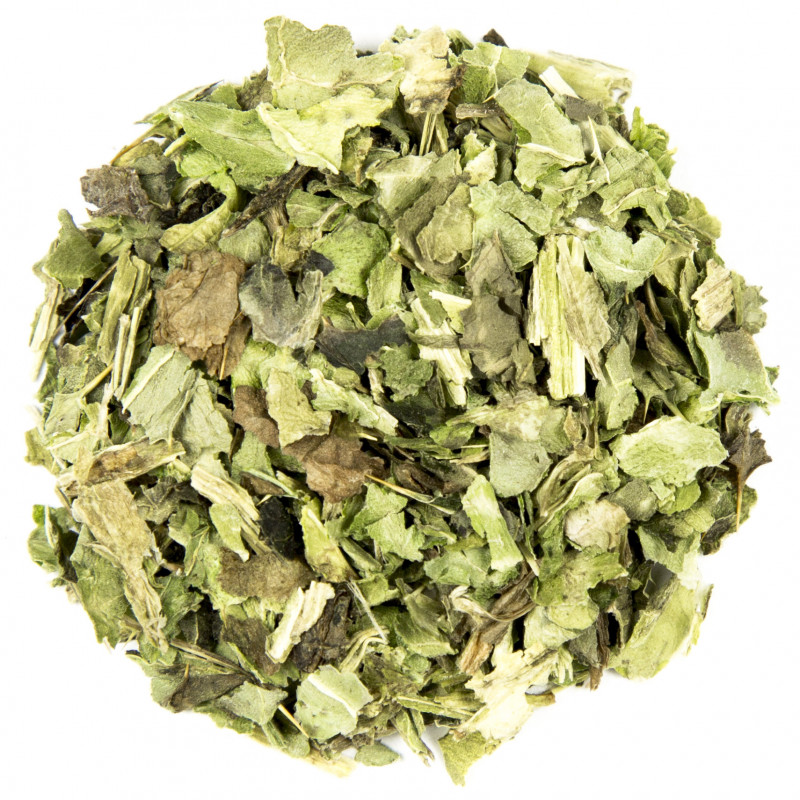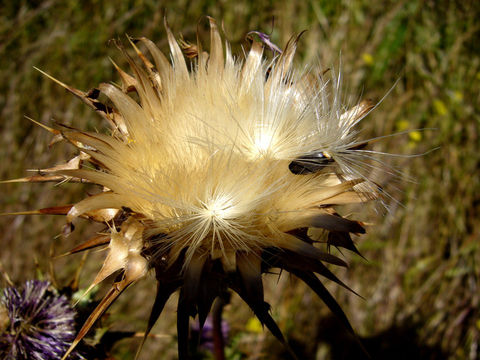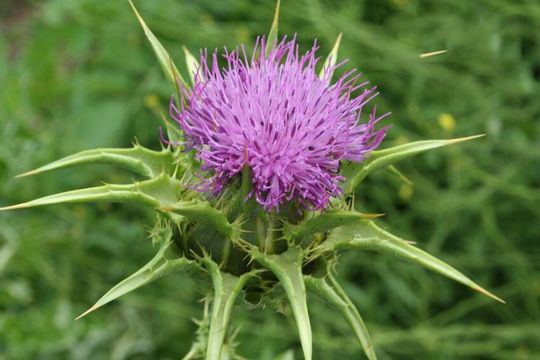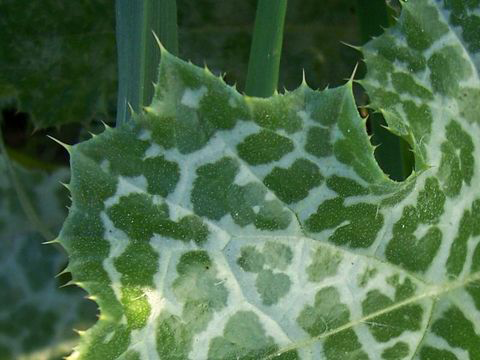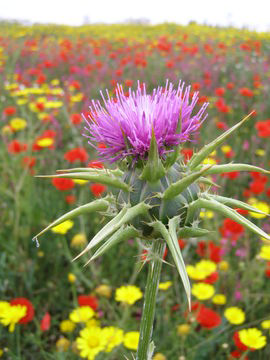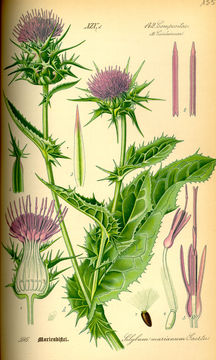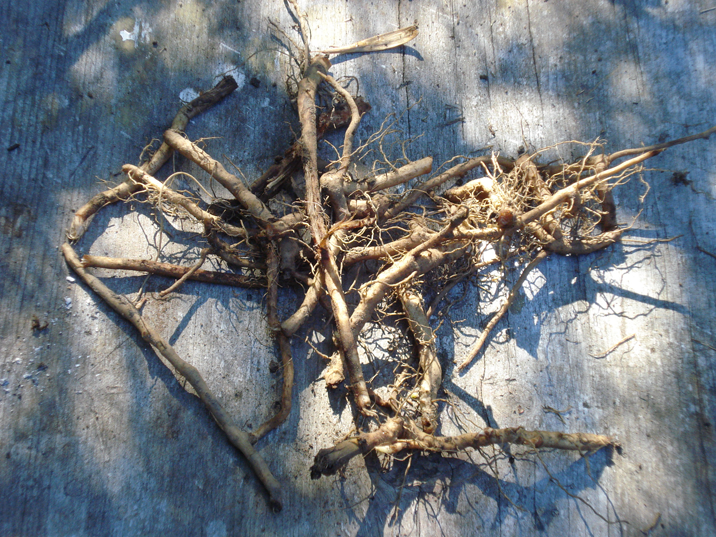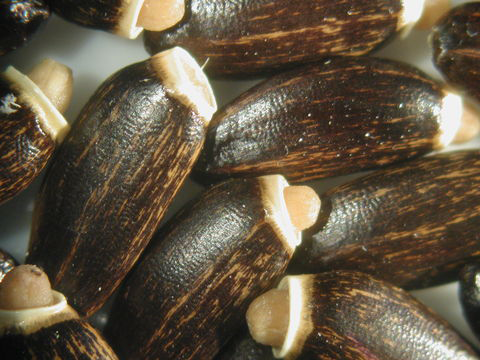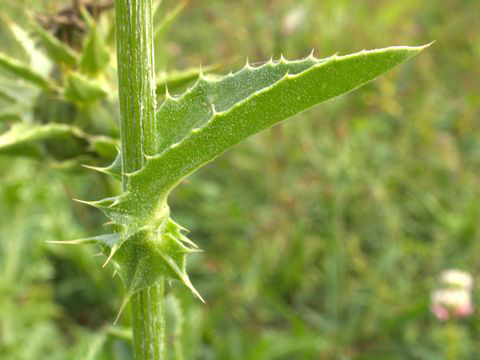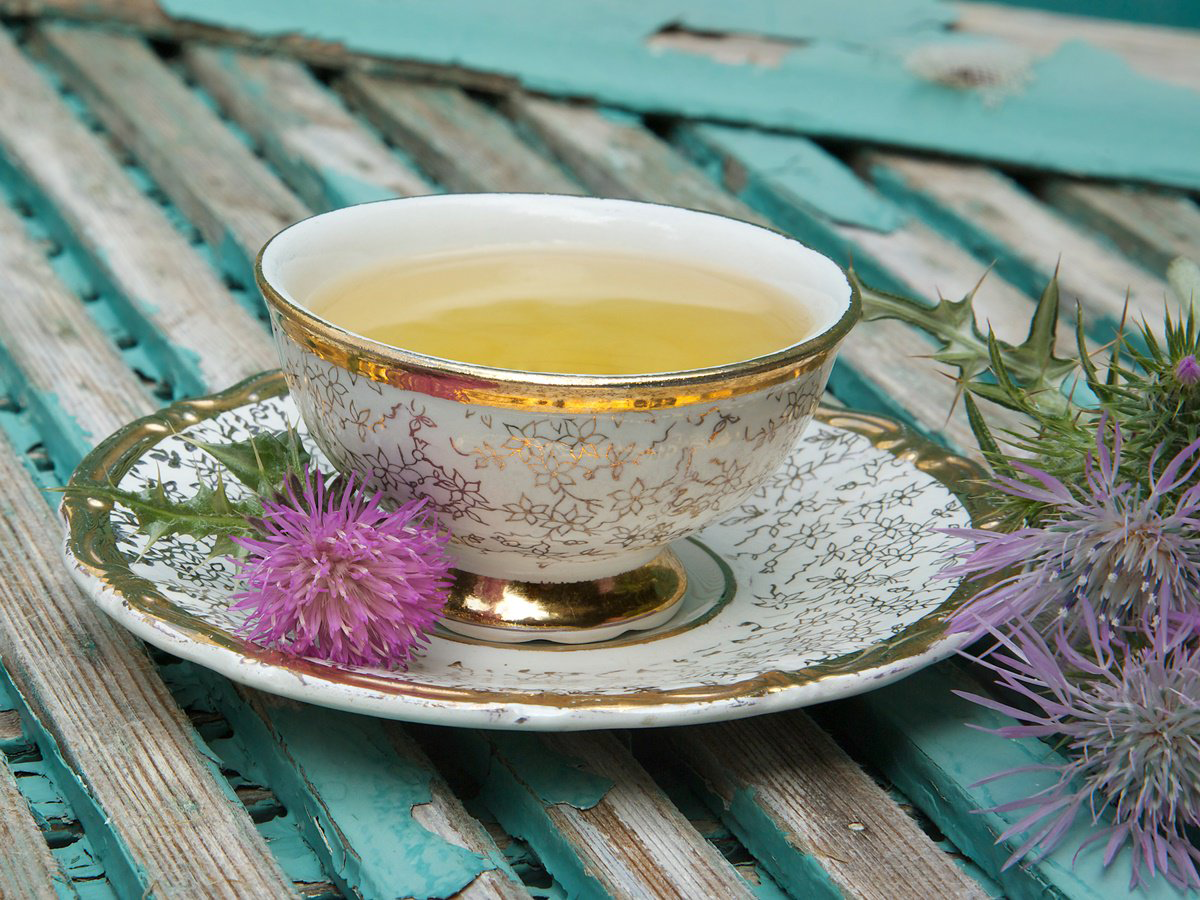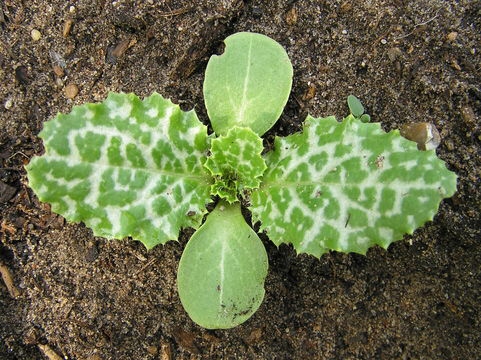| Milk Thistle Quick Facts |
| Name: |
Milk Thistle |
| Scientific Name: |
Silybum marianum |
| Origin |
Mediterranean countries |
| Shapes |
Achenes are black, with a simple long white pappus, surrounded by a yellow basal ring |
| Taste |
Sweet |
| Calories |
13 Kcal./cup |
| Major nutrients |
Potassium (15.28%)
Calcium (13.20%)
Vitamin B9 (10.43%)
Copper (8.94%)
Total dietary Fiber (6.58%)
|
| Health benefits |
Lowering high cholesterol and Prevents Cancer |
You may know milk thistle by different other names, depending on where you are in the world, including cardus marianus, blessed milk thistle, Marian thistle, Mary thistle, Saint Mary’s thistle, Mediterranean milk thistle, variegated thistle, Scotch thistle, blessed thistle, bull thistle, cabbage thistle, gundegai thistle, gundy, holy thistle, lady’s thistle, spotted thistle and St. Mary’s thistle. Scientifically, it is known as Silybmom marianum, and is an annual or biennial plant of the Asteraceae family which also includes ragweed, chrysanthemums, marigolds, and daisies. The plant is native to the Mediterranean region (southern Europe, western Asia and northern Africa). It has naturalized in parts of Europe, North America, South America, Australia and New Zealand. This plant is so widely known and highly praised due to the powerful organic components found in its seeds.
The plant gets its name from the milky white fluid that is expressed from the leaves when they are crushed. It is also called the “liver herb” due to its efficacy as a remedy against liver problems. Genus name comes from the Greek name silybon for some thistle-like plant. The plant is occasionally cultivated as an ornamental, a minor vegetable or as a medicinal herb. The flowers provide a useful source of pollen for bees in early summer. An extract (silymarin) from the seeds of the plant has been used for many years in the treatment of a variety of medical problems including liver disorders, gall bladder disorders, high cholesterol and mushroom poisoning.
Plant Description
Milk thistle is an annual or biennial herb that grows about 30 to 200 cm (12 to 79 in) tall. The plant is found growing in crop fields, pastures, forestry plantations, coastal areas, roadsides, disturbed areas and waste areas in temperate, sub-tropical and sometimes semi-arid regions and usually prefers areas of high fertility, such as alluvial flats, sheep camps, stock yards and other places with high soil nitrogen levels. Stem is erect, unwinged, grooved, slightly cottony, and simple or branched above. Leaves are oblong to lanceolate. They are either lobate or pinnate, with spiny edges. They are hairless, shiny green, with milk-white veins. Leaves and stems exude a milky sap when cut, hence the common name of milk thistle.
Flower and Fruit
Flower heads are 4 to 12 cm long and wide, of red-purple color. Mildly-scented, purple-pink flower heads (2″ across) is subtended by spiny bracts. Flowering normally takes place from Jul to September. The flowers provide a useful source of pollen for bees in early summer. Flowers are followed by achenes that are black, with a simple long white pappus, surrounded by a yellow basal ring and seeds are hard-skinned, brown, spotted, and shiny. The plant is cultivated as an ornamental, a minor vegetable or as a medicinal herb. An extract (silymarin) from the seeds of this plant has been used for many years in the treatment of a variety of medical problems including liver disorders and gall bladder disorders.
History
TH plant is originated in the Mediterranean region, western Asia and Russia, from where it has been spread to most temperate areas of the world.
Parsons and Cuthbertson suggested it was introduced to Australia as a medicinal plant. In Tasmania in 1832 the Hobart Town Courier expressed concern at it overrunning fertile soil. Elsewhere in Australia it was of enough concern to be included in the South Australian and Victorian noxious weed legislation in 1851 and 1861.
Darwin reported the invasiveness of S. marianum in South America in 1873: ‘very many (probably several hundred) square miles are covered by one mass of these prickly plants, and are impenetrable to man or beast. Over the undulating plains, where these great beds occur, nothing else can now live’.
In California S. marianum spread rapidly through the central valleys in the 1940s. King County reported that it was first found in King County, Washington, USA, in 1999 in an urban medicinal garden.
Health Benefits of Milk Thistle
Milk thistle is one of the most commonly used medicinal plants in the world and is also the number one recommended natural herb for liver health. In Europe, milk thistle is a prescribed medication. The milk thistle extract is suggested to treat mushroom poisoning, alcoholic cirrhosis, chronic hepatitis, drug and alcohol-induced liver damage and acute viral hepatitis, just to name a few. Popular health benefits of milk thistle includes
1. Diabetes Management
Milk Thistle consists of mixture of antioxidants, fatty acids, and sylimarin which can actually work to control insulin levels and maintain even blood sugar levels for people who suffer from or are at risk of developing diabetes. (1)
2. Anti-fungal Activity
Certain fungal infections can be neutralized with the use of milk thistle, and that probably relates to milk thistle’s traditional use as a remedy for mushroom poisoning. Many varieties of mushrooms are dangerous, and the “death cap” mushroom is particularly toxic, but milk thistle can be administered to prevent mortality.
3. Lowering high cholesterol
Milk thistle consists of potent anti-inflammatory properties which halt inflammation in its tracks. Inflammation is one of the primary causes of heart disease. This beneficial herb supports heart health by lowering high cholesterol levels and raising “good” or HDL cholesterol, as well as reducing inflammation and preventing oxidative stress damage to the arteries. Research concluded that when the extract silymarin was taken from milk thistle and used in combination with traditional treatments, total cholesterol as well as LDL, or “bad,” cholesterol, and trigylceride levels all improved, compared to participants’ cholesterol levels before taking the extract. (2)
4. Detoxifies the Body
Milk thistle extract is used as a detoxifying agent, due to its strong impact on the liver. As you know, the liver is responsible for handling many of the toxins in the body and eliminating them safely. Milk thistle’s range of organic components is very effective at stimulating the function of the liver and cleaning out the lymphatic system to keep your body running right.(3)
5. Better Digestion
In case you are suffering from digestion problems, milk thistle can help. Improper eating habits like unhealthy diet, overeating may cause indigestion and bloat related problems. In this time, consume the seeds of milk thistle herb on an empty stomach. This will help to draw the toxins out of your body thus facilitating digestion.
6. Prevents Cancer
Although research into milk thistle’s effects on cancer is still in its early stages, it seems that milk thistle extract can have an inhibitory effect on the growth of cancer cells and tumors on the skin and can also help prevent cancerous growth in the prostate, breast, and cervix. Given the rapidity and mortality rates of those particular types of cancer, milk thistle extract may be a major herbal advantage.(4)
7. Promotes Healthy Skin
Topical preparations of milk thistle extract is quite beneficial the skin. Animal research has found that silymarin encourages normal skin cell development in mice. One observational research concluded that a topically-applied, silymarin-based skin cream effectively encourages healthy skin. Preliminary investigations have even begun to examine the potential of silymarin as a natural replacement for conventional sunscreen. (5)
8. Organ Repair
When people suffer from liver disease or cirrhosis, the liver is essentially compromised and its functions suffer. While this damage to the liver can be reversed, it is a slow process. Milk thistle extract can help to speed up the healing process in the liver, undoing much of the damage from excessive drinking or other damaging behaviors on the liver.(6)
9. Improves Heart Health
Milk thistle extract consists of high concentrations of beneficial fatty acids and omega-3s, which are necessary for maintaining heart health. Omega-3 fatty acids are able to balance the cholesterol levels in your body, which can prevent atherosclerosis, thus lowering your risk of experiencing a stroke or a heart attack.(7)
10. Delays Ageing
Milk thistle keeps your skin glowing and radiant. Its ability to promote healthy cell growth also means that it will help delay aging to a certain extent. There may not be any strong evidence that milk thistle benefits your skin. But, it has the properties that benefit the different parts of your body, such as the liver, kidney, colon, blood, etc. which in turn have fantastic effects on your skin. When your body is healthy from the inside, it shows on the outside as well, meaning that you will naturally have glowing and healthy skin all the times.
11. Treats Hangovers
In case you are not unable to get over your hangover, Milk thistle is the best options. Add some milk thistle herbs to your tea and sip on it to hydrate yourself. After a while, you will notice that you feel much better. This is because milk thistle helps in flushing out the toxins from your body thus hydrating you.
12. Alzheimer’s disease
This is a relatively new area of research for milk thistle, but some researchers believe that using milk thistle extract can stimulate cognitive ability and open up new neural pathways, successfully slowing the onset of dementia and Alzheimer’s disease.(8)
13. Prevents Hair Loss
Milk thistle plant has ability to detoxify your body and it is one of the reasons why milk thistle is often suggested as a remedy for hair loss. Well-balanced and healthy body is supposed to strengthen hair, hence preventing hair fall and loss of hair.
https://www.youtube.com/watch?v=In4nNdBzKsY
Traditional uses and benefits of Milk Thistle
- Milk thistle is used in traditional Chinese medicine to clear heat and relieve toxic material, to soothe the liver and to promote bile flow.
- It is sometimes suggested by herbalists to help treat liver diseases.
- Blessed thistle has a long history of use in the West as a remedy for depression and liver problems.
- Research has confirmed that it has a remarkable ability to protect the liver from damage resulting from alcoholic and other types of poisoning.
- Whole plant is astringent, bitter, cholagogue, diaphoretic, diuretic, emetic, emmenagogue, hepatic, stimulant, stomachic and tonic.
- It is used internally in the treatment of liver and gall bladder diseases, jaundice, cirrhosis, hepatitis and poisoning.
- It improves liver regeneration in hepatitis, cirrhosis, mushroom poisoning and other diseases of the liver.
- German research suggests that silybin (a flavonoid component of the seed) is clinically useful in the treatment of severe poisoning by Amanita mushrooms.
- A homeopathic remedy is obtained from equal parts of the root and the seed with its hulls still attached.
- It is used in the treatment of liver and abdominal disorders.
- Roots and seeds are made into infusions to relieve jaundice and the leaves and heads are used as poultices to ease pain.
- It controls blood sugar level and treats the problems of Diabetes.
- It is a good herbal cure for gallstones.
- It cures brain problems like hangover and Alzheimer’s disease.
- It is effective treatment for Allergic reactions.
- Its extract is an Antidote for Mushroom poisons.
Ayurvedic Health benefits of Milk Thistle
- Alcoholism: Take Milk Thistle extract daily. OR Eat the seeds.
- Hepatitis A: Purchase the extract of Milk Thistle from Market. Take ¼ cup thrice a day.
- Hepatitis D: Make a decoction of the leaves of Milk Thistle. Take twice a day.
- Acid Reflux: Make an infusion of Milk Thistle’s seeds. Drink thrice a day.
- Gallstones: Powder dried seeds of Milk Thistle. Take half tsp early in the morning and at bed time.
- Liver Disease: Add fresh leaves of Milk Thistle in salad. OR Have one cup of the decoction of Milk Thistle leaves. OR Take 180 mg Milk Thistle capsules two times a day for the month.
- Galactagogue: Nursing mothers should include Milk Thistle in their daily diet. Especially the white sap is very useful for increasing lactation.
- Hangover: Add 10-15 drops of Milk Thistle liquid extracts in a glass of water. Drink it 20 to 30 minutes before drinking alcohol. It speeds up the recovery from Hangover symptoms.
- Multiple Sclerosis: Boil a cup of water and put two grams of powdered Milk Thistle seeds in the bowl. Boil the mixture for 10 minutes. Strain it off. Drink this decoction thrice a day.
- Liver Tonic: Put 1 to 2 tsp of Milk Thistle seed powder in 100 ml of hot boiling water. Boil it for 10 minutes. Drink it lukewarm. It removes the toxin from the body.
- Gilbert’s Syndrome: Have Milk Thistle extract 250 mg twice a day.
- Non Hodgkin Lymphoma: Consume Milk Thistle seed extract, 160 mg two times a day.
- Spleen Enlargement: Take a half tbsp of Milk Thistle powder with Milk. OR It is also available in capsule form. Take 1 capsule a day.
- PCOS: Milk Thistle is a good liver tonic. Have 1 capsule every day.
- Uterine Fibroid: Take 1 tablet every day.
- Liver Corrhosis: Milk Thistle capsules are available in market. Have 2 every day.
- Asthma: Take sundew, Grindelia and milk thistle. Prepare a decoction. Drink 2-3 times a day.
- Kidney stones: Take equal amount of Caper roots, Caper thorns, Milk Thistle, Aerva Lanata, Pavonia. Grind them together. Boil in water until it remains one fourth. Have 3 tbsp twice a day.
- Gastroparesis: Take equal amount of Wild candytuft, Angelica root, Milk Thistle fruit, Caraway fruit, Licorice root, Peppermint, Chamomile flower, Chelidonium Majus and lemon balm leaves. Grind them together. Take one tsp powder with lukewarm water once a day. OR Prepare a decoction of above given herb. Drink half cup twice a day.
- Gallstones: Take Dandelion root, Milk Thistle, birch leaves and stinging Nettle leaves in equal amounts. Make a tea by boiling all these herbs together and drink regularly to prevent Kidney and Gallstones.
Culinary Uses
- Roots can be eaten raw or boiled and buttered or par-boiled and roasted.
- Young shoots can be cut down to the root and boiled and buttered.
- Spiny bracts on the flower head were eaten in the past like globe artichoke, and the stems can be soaked overnight to remove bitterness and then stewed.
- Leaves can be trimmed of prickles and boiled and make a good spinach substitute or they can also be added raw to salads.
- Leaves are quite thick and have a mild flavor when young, at this time they are quite an acceptable ingredient of mixed salads, though they can become bitter in hot dry weather.
- When cooked they make an acceptable spinach substitute.
- Flower buds when cooked are a wonderful globe artichoke substitute.
- Stems can be used like asparagus or rhubarb or added to salads.
- Good quality oil is obtained from the seeds.
- Roasted seed is a coffee substitute.
Different Ways to Use Milk Thistle in Your Daily Diet
Milk thistle is a versatile herb that can be consumed in many ways to gain its many benefits. It is found in tablet, capsule, gel, powder and tincture form. Many people purchase milk thistle supplements as they are easily available than it is in its fresh plant form.
Here are some of the ways on how to take milk thistle and make it a part of your daily diet:
1. Tea
Apart from tablet or capsule supplements and tinctures, milk thistle is also available in the form of packaged tea. Each tea bag has all the goodness of this miraculous herb. So, a cup a day can give you all the health benefits. If you have fresh leaves of milk thistle, you can also brew homemade tea with crushed leaves steeped in hot water for about 5 minutes or so. You can add honey for extra goodness and flavor!
2. Diluted Tincture
If you have milk thistle in tincture form, you can always add it to a glass of water and drink it every morning or evening. All you can need is a few tiny drops of the tincture to benefit from the magical effects of this herb.
3. Seeds in Powder Form
Seeds are the most used part of the milk thistle. If you want to benefit from the potent powers of this herb’s seeds, then you can use it in its powdered form. You can sprinkle the powder to any dish that you cook. It also makes an amazing ingredient for salad dressings, sauces, etc.
4. Milk Thistle Smoothie
You can add milk thistle in fruit smoothie in the mornings for breakfast. All you need to do is soak some ground seeds of the herb in water overnight and add it to your smoothie in the morning. You could also try it with lyceum berries that have been chopped and put in a blender with some citrus lemon juice!
5. Juice
You can add crushed milk thistle seeds or the powder to your daily glass of fruit juice for that extra goodness! You will certainly love something that gives your healthy fruit juice more benefits that your body will thank you for.
Dosages
If you are wondering how much milk thistle you should take in a day, experts recommend about 100 to 250 milligrams a day. Consuming more than this could cause side-effects such as nausea, headache, stomachache, skin irritation and itching. This is why experts advise that you consult your physician before you start adding milk thistle to your diet in its fresh or supplement form. It is especially important to do this if you are taking medication for various ailments or disorders.
Other Facts
- The plant has been found to be toxic to cattle and sheep.
- A good green manure plant, producing a lot of bulk for incorporation into the soil.
When to Avoid Milk Thistle
Even though milk thistle is overloaded with many health benefits and medicinal properties, it is very important to understand that it could also have adverse effect in certain situations and medical conditions.
Given below are few of the medical conditions and situations when you should avoid using milk thistle at all:
1. Avoid If You Pregnant or Lactating
Milk thistle is known to have adverse effects on pregnant women and cause problems for lactating women. Even though there is no hard core evidence to establish this as a set fact, doctor’s advice to take precautions to avoid any side effects that could have a life altering impact on the child and the mother, or both.
2. Avoid If You Are Allergic To Asteraceae or Compositae
Milk thistle belongs to the family of Asteraceae or Compositae. If you are allergic to any of the plants like daisies, marigolds, ragweed, chrysanthemums, etc., it is advisable to avoid milk thistle. Since there are chances that you may end up with an allergic reaction and need medication to fix it. Also, reach out to your doctor for further advice.
3. Avoid If You Have Been Advised To Reduce Estrogen
In case of any disease that is related to the reproductive system, doctor might or could advise you to watch the estrogen level in the body. It is best to avoid milk thistle in such a situation as the plant estrogen might cause problem and complications.
References:
https://www.itis.gov/servlet/SingleRpt/SingleRpt?search_topic=TSN&search_value=38413#null
https://davesgarden.com/guides/pf/go/1056/
http://www.hear.org/pier/species/silybum_marianum.htm
https://npgsweb.ars-grin.gov/gringlobal/taxonomydetail.aspx?id=33952
http://www.pfaf.org/user/Plant.aspx?LatinName=Silybum+marianum
https://www.mskcc.org/cancer-care/integrative-medicine/herbs/milk-thistle
http://www.cabi.org/isc/datasheet/50304
http://www.missouribotanicalgarden.org/PlantFinder/PlantFinderDetails.aspx?taxonid=277472&isprofile=0&
http://www.floracatalana.net/silybum-marianum-l-gaertn-
http://www.umm.edu/health/medical/altmed/herb/milk-thistle
https://www.drugs.com/npp/milk-thistle.html
https://www.botanical.com/botanical/mgmh/t/thistl11.html#mil
http://www.theplantlist.org/tpl1.1/record/gcc-114114
https://plants.usda.gov/core/profile?symbol=sima3
https://en.wikipedia.org/wiki/Silybum_marianum
Comments
comments


